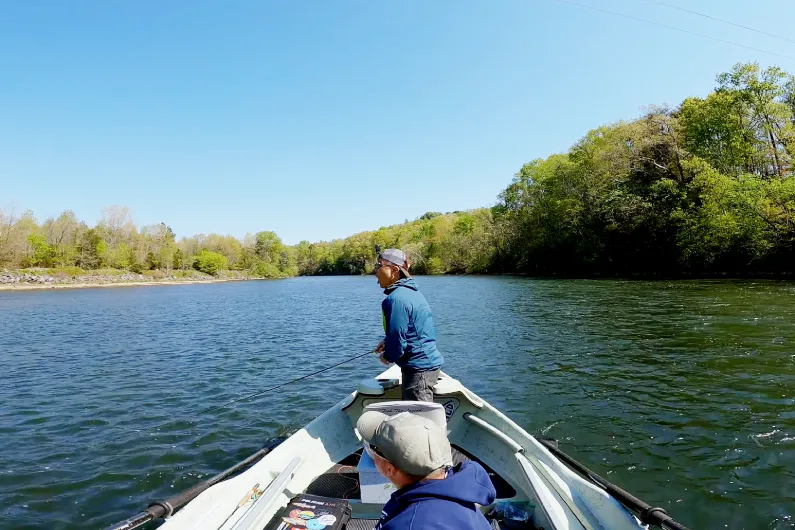Key Takeaways:
- Tennessee offers diverse fly fishing opportunities, with various rivers, lakes, and creeks providing excellent angler locations.
- Anglers can enjoy fishing for various trout species, including brown, rainbow, and brook trout, as well as other species like largemouth bass, smallmouth bass, crappie, and striped bass in certain locations.
- Spring and fall are generally the best seasons for fishing, with hatches and feeding activities more abundant during these times.
- Fishing regulations, including licenses, catch limits, size limits, and bait regulations, must be adhered to for responsible and sustainable fishing.
- Some locations have unique features, such as scenic beauty, unique lake formations, and endangered fish species, adding to Tennessee’s overall fly fishing experience.
16 Best Places to Fly Fish in Tennessee
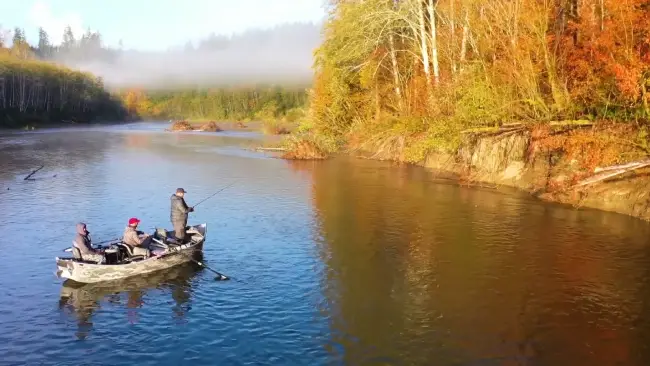
Tennessee is the perfect fly fishing destination for those seeking great fishing, beautiful scenery, and rich history. The state is home to some of the best trout streams and offers anglers a range of fishing experiences from mountain streams to tailwaters.
Here are the 16 top spots for fly fish in Tennessee:
- Clinch River
- Hiwassee River
- Reelfoot Lake
- Abrams Creek
- Caney Fork River
- Chickamauga Reservoir
- Elk River
- Holston River
- Melton Hill Reservoir
- Obey River
- Tellico River
- South Holston River
- Watauga River
- Hurricane Creek
- Citico Creek
- Duck River
Let’s discuss these places in more detail:
1. Clinch River
- Flows southwest for over 300 miles along the U.S. Great Appalachian Valley in the states of Virginia and Tennessee, taking in various tributaries, such as the Powell River.
- Great sulfur hatches in spring and early summer and year-round trout fishing due to consistent water temperatures from the cold water flow at the base of Norris Dam.
- One of the finest tailwaters in the US, offering exceptional fly fishing opportunities for trout species, including rainbow, brown, and brook trout.
2. Hiwassee River
- Located in today’s Polk County, Tennessee, where the Hiwassee River emerges from the mountains and passes through the Cherokee National Forest and the historic towns of Reliance.
- Trout fishing is good year-round for hatches and feeding activities from late spring to early fall.
- Unique river offering excellent fly fishing options for trout species. Also, large streamers can target large striped bass in the summer.
3. Reelfoot Lake
- Shallow Lake on the boundary between Lake and Obion counties in northwestern Tennessee, U.S., near Tiptonville.
- Winter home for bald eagles, a thriving fish population, productive crappie fishing in spring and fall, and bass fishing in summer.
- Unique Lake was formed by a massive earthquake in the early 1800s, offering excellent fly fishing opportunities for various species, including crappie, bass, and other fish.
4. Abrams Creek
- Located inside Cades Cove in the Great Smoky Mountain National Park in Tennessee.
- The best time for fishing is during trout fishing season from early spring to late fall, but spring and fall are particularly great times for fishing.
- Known for its scenic beauty and large rainbow trout, this park is home to some of the largest trout in the world.
5. Caney Fork River
- Situated at the confluence of the Caney Fork, the Collins River, and the Rocky River is Great Falls Lake.
- Fishing can be good year-round, but summer is a good time to target big brown trout during dam releases.
- Tailwater is known as one of the region’s finest trout fisheries, offering opportunities to catch big brown trout and smaller stocked rainbow, brown, and brook trout.
6. Chickamauga Reservoir
- Located on the Tennessee River just north of Chattanooga, Tennessee. The reservoir stretches 59 miles upriver from the Chickamauga Dam.
- Fishing can be productive throughout the year, but spring and fall are excellent seasons for bass fishing.
- Excellent opportunities for fly fishing for big largemouth bass, and it holds the current Tennessee state record for largemouth weighing over fifteen pounds. Also good for crappie, bluegill, and large striped bass.
7. Elk River
- The river rises in Grundy County, near the community of Elkhead in Tennessee, in Burroughs Cove. The Elk River is a branch of the Tennessee River and Alabama.
- Good fly fishing throughout the year and late spring, summer months, and early fall are ideal times to visit.
- Smaller and more intimate trout river, known for excellent fly fishing opportunities with a constant supply of stocked trout.
8. Holston River
- A 136-mile river that flows from Kingsport, Tennessee, to Knoxville, Tennessee.
- Excellent fishing opportunities throughout the year; spring is rewarding for trout fishing during the caddis hatch.
- Renowned for excellent fishing opportunities for trout and smallmouth bass, with a quick growth rate providing chances at trophy-sized fish.
9. Melton Hill Reservoir
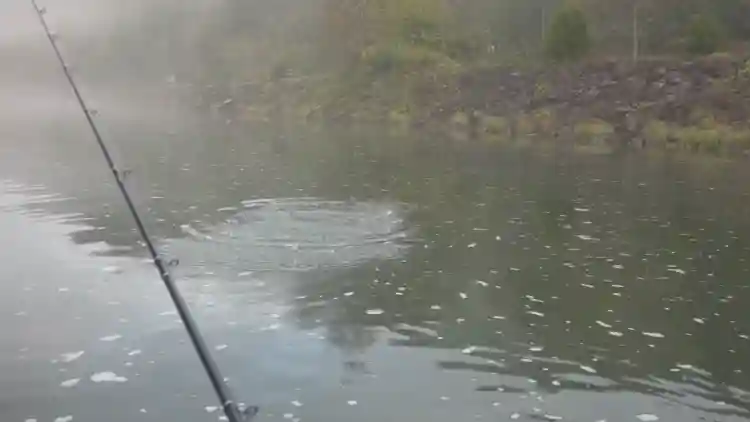
- About 5,690 surface acres located on the Clinch River near Oak Ridge, Tennessee.
- Best fishing during warmer months, but the long growing season contributes to trophy-sized striped bass and muskellunge.
- Known for excellent fishing opportunities, particularly for striped bass and muskellunge, thanks to consistent water temperatures from cold-water inflow.
10. Obey River
- A 47.8-mile-long tributary of the Cumberland River in the U.S. state of Tennessee, flowing through the Cumberland Plateau region.
- The best time for fly fishing is in the cooler months of spring and fall, but late spring, summer, and early fall are excellent times to visit.
- Renowned for excellent trout fishing opportunities, offering various species, including rainbow, brown, and brook trout.
11. Tellico River
- Located in eastern Tennessee, flowing through the Cherokee National Forest in the Tellico Plains area.
- The optimal fly fishing time is in the spring and fall, but fishing permits are required in this creek to protect endangered fish species.
- Excellent fly fishing opportunities for wild rainbow, brown trout, and brook trout make it a prime destination for fly fishing enthusiasts.
12. South Holston River
- Located in northeastern Tennessee, flowing from Virginia to Bluff City, where it enters Boone Lake.
- Dry fly fishing is possible in various seasons during the sulfur hatch, with excellent fishing opportunities throughout the year.
- Renowned as one of the best trout streams in Tennessee and the eastern United States, offering excellent fly fishing opportunities for wild brown trout.
13. Watauga River
- Located in northeastern Tennessee, flowing from Watauga Lake near Elizabethton and running through Johnson City before eventually crossing into North Carolina.
- The ideal time for fly fishing is during cooler months in spring and fall and optimal conditions for trout feeding and active fishing.
- Exceptional trout fishing opportunities offer diverse trout species, including brown, rainbow, and brook trout.
14. Hurricane Creek
- Situated nearby to the hamlets Jeremiah and Brotherton, west Tennessee.
- The best time for fishing is around the stocked trout season in late winter and early spring.
- Great fly fishing experience for various fish species, including rainbow trout, largemouth bass, smallmouth bass, rock bass, and several sunfish species.
15. Citico Creek
- Located in the Cherokee National Forest in eastern Tennessee.
- The most suitable time for fly fishing is around the stocked trout season, but a special permit is required for fishing due to protecting endangered fish species.
- Known for being a top fly fishing destination, offering some of the state’s best wild trout fly fishing.
16. Duck River
- Situated in middle Tennessee, US.
- The prime time for fishing is during the stocked trout season below the Normandy Dam in late winter and early spring, but Wade fishing is popular in the 14 miles of tailwater flowing from the Wilbur Dam.
- Known for its abundance of fish species, including brown and rainbow trout, spotted bass, rock bass, channel catfish, and sunfish.
What is the best time to fly fish in Tennessee?
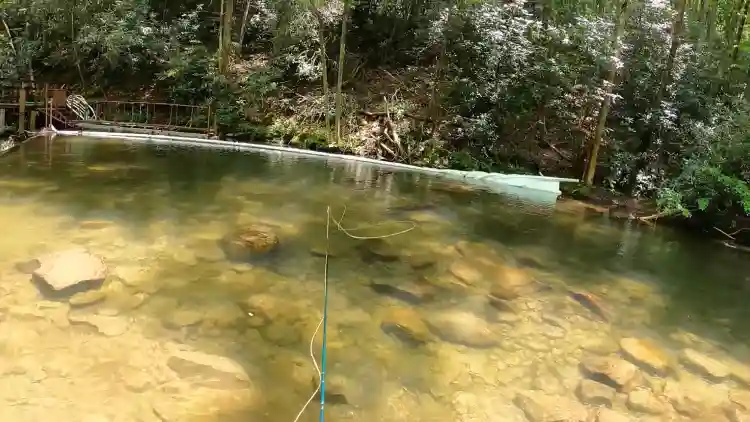
It’s hard to choose just one destination for fishing in Tennessee when there are so many great options. Each river and lake have its best seasons and times for the most productive fishing.
For instance, due to the sulfur hatch, the Clinch River is best during spring and early summer. At the same time, the Hiwassee River is more productive during the late spring to early fall when hatches and feeding activity are more abundant.
If you’re looking for a place to catch some crappie in Tennessee, Reelfoot Lake is perfect during spring and fall, but summer is the best time if you’re after bass. Abrams Creek is known for its trout fishing season from early spring until late fall, making it an excellent location for fishing enthusiasts.
Heading over to Caney Fork River, you’ll find that spring, fall, and summer are great for fishing, especially when the dam releases water for power generation during summertime. For largemouth bass, spring and fall are ideal fishing seasons in Chickamauga Reservoir.
The Elk River is well-stocked, perfect for fishing during late spring, summer, and early fall. Holston River is another great year-round option, with trout fishing particularly rewarding during spring and smallmouth bass fishing during spring and summer.
With cooler temperatures comes better trout fishing, making Obey River the go-to river during the cooler months, especially in spring and fall. Tellico River’s stocked trout period in late winter and early spring is the best time to visit if you’re after stocked trout.
South Holston River is another year-round option with various hatches, particularly the sulfur hatch. If you’re interested in a fishing trip during stocked trout season, remember to check out Hurricane Creek and Citico Creek during February, March, and April.
Also, Duck River is the perfect summer spot for catfish, bass, and sunfish fishing, while stocked trout season keeps things exciting in the late winter and early spring. Tennessee is truly a fisherman’s paradise, and there’s something for everyone.
Which fish species can be caught in Tennessee using fly fishing?
There are a lot of fish species you can catch when you fly fish in Tennessee. You can catch trout species like rainbow, brown, and brook in popular areas such as the Clinch River, Hiwassee River, and Reelfoot Lake.
But that’s not all! There are also crappie, bass, and other species waiting to be caught in Reelfoot Lake, while Chickamauga Reservoir offers largemouth bass, crappie, bluegill, and large striped bass.
If you want to catch brown and rainbow trout, check out Melton Hill Reservoir. And for those who want a challenge, Hurricane Creek offers rainbow trout. For those who want something more adventurous, you can catch wild and stocked trout in streams like Citico Creek and the South Holston River.
But the excitement doesn’t stop there. The Duck River offers brown and rainbow trout, spotted bass, largemouth bass, rock bass, channel catfish, freshwater drum, and various sunfish species. Fly fishing in Tennessee is a fantastic adventure that offers a wide variety of fish species for all fly fishing enthusiasts.
What are the fly fishing regulations in Tennessee?
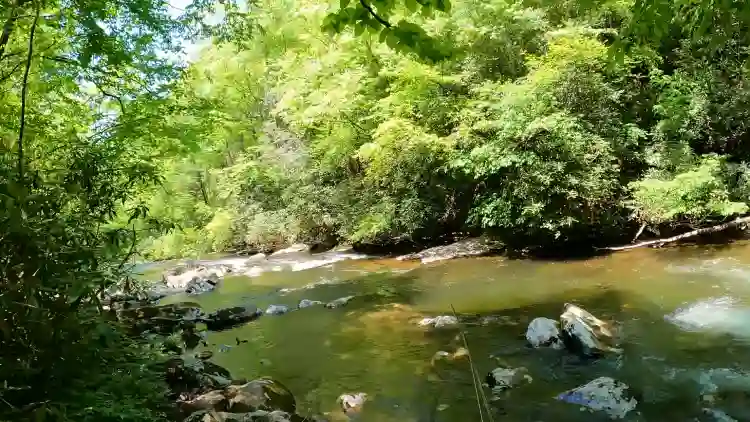
Fly fishing regulations in Tennessee are established and enforced by the Tennessee Wildlife Resources Agency (TWRA) to ensure the sustainable management of fish populations and the protection of aquatic ecosystems. Here are some key fly fishing regulations that anglers should be aware of when fishing in Tennessee:
- Fishing License: Anglers are required to possess a valid fishing license to fish in Tennessee waters. The license allows individuals to engage in recreational fishing activities and supports conservation efforts to maintain healthy fish populations.
- Catch Limits: The TWRA sets daily catch limits for certain fish species. These catch limits specify the maximum number of fish of a particular species that an angler can catch and keep in a single day.
- Size Limits: Some fish species have size limits, which means anglers are not allowed to keep fish that fall below or exceed a certain length. Size limits are implemented to protect young fish and ensure that adult fish have a chance to reproduce and contribute to the overall fish population.
- Catch and Release: In some waters or during specific periods, catch and release regulations may apply to certain fish species. Catch and release means that anglers must return the fish to the water immediately after catching them without keeping any for harvesting.
- Bait Regulations: There may be restrictions on the bait that can be used for fishing in certain waters. For instance, using live bait or certain artificial lures might be prohibited to prevent the spread of invasive aquatic species that can harm native fish populations and habitats.
- Trotlines, Limblines, and Jugs: For specific fishing methods like trotlines, limblines, and jug fishing, there are rules on their use.
- Fishing Seasons: Some waters might have specific fishing seasons, during which fishing is allowed or prohibited to protect fish during critical life cycle periods. Seasonal regulations help maintain sustainable fish populations and ensure that fish can spawn and reproduce.
- Aquatic Invasive Species: Regulations may be in place to prevent the spread of invasive species. Anglers might be required to take certain measures to clean and disinfect their fishing gear to avoid introducing harmful species to new waters.
- Special Regulations for Specific Lakes: Some lakes might have special regulations, such as catch limits, size limits, and protected length ranges, tailored to the particular fish species in those waters. Anglers must follow these lake-specific regulations to support conservation efforts.
#Note: These regulations are implemented to protect fish populations, maintain ecological balance, and promote responsible fishing practices. Anglers can obtain detailed and up-to-date information on fishing regulations from the TWRA website or by contacting the agency directly.

